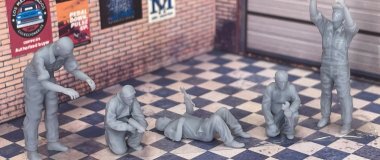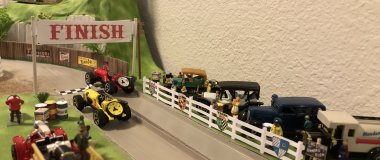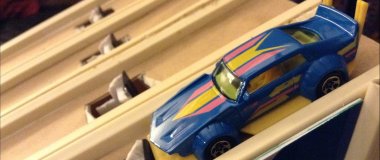The teacher making diecast racing cool for school
It's been many decades since I was in grade school but I can tell you that diecast racing wasn't a thing back then. It wasn't a thing with my friends, and it certainly wasn't a thing at school. Thankfully, things have changed over the last 30+ years.
Recently, member CPMS_Raceway, shared a build journal of the race track he started putting together in his middle school classroom. I reached out to learn more and got a chance to talk with Leigh Evans, the teacher taking his class of 6th graders at Clark-Pleasant Middle School in Indiana along for a fantastic ride.
I chatted briefly with Leigh to learn about how and why a race track ended up in his classroom. But I also wanted to ask him about some of the educational value diecast racing can bring to school-age kids...and who better to ask than a teacher? I don't know about you, but things might have been different for me in school if a teacher had thought to make Hot Wheels racing an extracurricular activity.
It's wonderful to see our hobby in schools as a fun way to get kids engaged in learning. Hopefully my chat with Mr. Evans can inspire you to get more involved with your community by way of racing - and if you're a teacher, get the racing into your school!
Please check out the CPMS International Raceway and Proving Grounds build journal article to join the discussion and see more photos.

Interview with Leigh Evans
Redline Derby Racing: We always start these off easy. Tell us a bit about who you are and where you are.
Leigh Evans: My name is Leigh Evans. I am in my 32nd year of teaching middle school, and I live in Greenwood, Indiana - about 10 minutes south of Indianapolis.
RLD: What's your personal history with diecast racing? It's probably safe to assume you enjoyed toy cars as a kid but how did they find their way back into your life?
Leigh: Absolutely. I grew up with the orange track running from the kitchen table across the floor into the living room. I've also been around them my whole professional life as I am surrounded by 11-year olds :) During COVID, like many people, I spent more time online and ran across your site. I was simply amazed at what diecast racing had become. The simple tracks of my youth, while still around and enjoyed, are now competing with extreme layouts complete with landscaping and video production!
RLD: You posted a build journal on the RLD website showing off your track and explained that it's located in your classroom. How and why did a race track make its way into your classroom? What was your motivation to put a track in school?
Leigh: One of the unfortunate changes that often takes place at the middle school level, is the shift away from liking school. More times than not kids enjoy school at the elementary level, but by the time they enter high school, they have a very negative view of it. We still have recess period in sixth grade as well as a period for enrichment. These are the times the track is developed and used. As far as space, it really doesn't take up much space against one wall. Put simply, I hope this is another reason for kiddos to want to come to school - something they can look forward to.

RLD: What was the reaction of your students and faculty? Was a track in the classroom a tough sell to the principal?
Leigh: The kids have been over the moon for sure, and the other teachers are very curious. They all have their own experiences with Hot Wheels as kids, so many of them have stopped in to ask about it and even watch races. The track pieces were part of a grant I was awarded.
RLD: How have the students helped in designing and building the track? Is it extra credit?
Leigh: No, no extra credit :) But, yes, the kids love to help design and lay it all out. So much testing to make sure this turn works or that straight has enough speed etc, and while I grow tired of that particular aspect of it, the kids can't get enough.
RLD: Gravity racing has some built-in educational value when it comes to physics and other STEM type things, but I see a lot of extra learning potential in other ways too like art, modeling, writing, media production, collaboration, etc. In what other ways do you think diecast racing can be beneficial to school-agers beyond the obvious science?
Leigh: This is exactly what I had in mind. There is really no end to the directions we could go with this. As we are just scratching the surface now, I foresee having focus weeks dedicating our track time to different areas of our curriculum as you mentioned.
RLD: Have you thought about creating a diecast racing club at your school? I went to a small school and there was barely enough interest to justify a chess club, but I imagine it wouldn't be difficult to get kids to buy-in for a race club.
Leigh: There has already been a great deal of interest shown in something like this. Every time our designated track times end, the groans go up. The more time the better as far as the students are concerned. Not everyone is an athlete or a musician, and it's nice to have clubs for those students as well.
RLD: Do you have any plans to share your diecast racing beyond the classroom? Maybe it's tricky given it involves kids and all the school politics, but it would be pretty awesome to have the kids produce a video or something to show off their hard work and creativity. Or maybe incorporate the racing with school fundraising efforts.
Leigh: That would be tough given the nature of schools at present, but for now it is serving its purpose with the students. All are familiar with Hot Wheels but few have access to anything as big as this setup. I know nothing about the video production side of this beyond watching races online, but I can tell you this: middle school students are ridiculously tech savvy, and given the opportunity, there will be some that would love to figure it out and give it a shot.

RLD: Right now, your track is a work-in-progress. You have the supports and course figured out. What materials and parts have you used to build it, and what else is on your wishlist to complete your track?
Leigh: At this point we have already gone through two complete rebuilds. I am torn between creating a permanent course or letting the students redesign as they see fit. Paper boxes, coroplast sheets, and standard orange track are our main building blocks. I have two 180-degree turns from JLHKrafts, a handful of chicanes, and a starting gate. That's all we've utilized so far, but I also have some open lane pieces from a Crash Racers set. No real wish list, as we have all that we can really deal with at this point. The kids love building so much, it's hard to see a permanent layout at this point, but we'll see.
RLD: What was the biggest challenge you encountered when building/designing your track?
Leigh: No true challenges. As I mentioned, the students love the testing process. So what I see as tedious, they just see as fun. We are fortunate to have such a big room with tables as a starting point. Having this much space, this much track, and this many excited sixth graders, the process is a blast!
RLD: Track building is one aspect of diecast racing but so is modifying cars and customizing them. Do you have any plans to incorporate that experience into your racing at CPMS? I guess if it involves power tools, maybe not…ha!
Leigh: Power tools, probably not at school at least, but the scientific process with variables and constants, as well as trials and tracking/graphing data are all part of our science curriculum. So modifying cars is a natural progression. We have a gram scale and a digital finish line that measures down to 10 thousandths of a second. Both of these are outstanding tools to help students with the scientific process of shaving time.
RLD: I think it's really wonderful that you've incorporated diecast racing in the classroom and I'd like to think it's something within reach for many teachers across the country. What tips and suggestions would you give to other educators that want to start something similar in their school? Any major hurdles and gotchas to avoid?
Leigh: It has been an absolute joy so far. As I mentioned earlier, I was able to afford the actual track as it was funded by a grant that I wrote-up. I think these types of funding opportunities are out there in many schools, and it just takes having an idea and applying. Getting the students on board is the easiest sell I've ever had.
In terms of pitfalls, obviously there has to be ground rules with so many students having access to the track. There is a "Track Closed" sign that is displayed during class time, and the kiddos have been very respectful of this. With so many eager hands, even during track time, assigned roles make for a smoother process. Not everyone can build at one time as there are simply too many hands, but the students are content to take turns. Likewise, designated starters, car retrievers, and bracket and time keeping roles can help as well.
RLD: Are there any other stories, shoutouts, or links you care to share about your track, your class, or your school?
Leigh: A big thank you to your website for keeping the childhood joy of diecast racing alive and well and serving as inspiration for projects like mine. Very, very grateful!
I'd like to thank Leigh for taking the time to talk about his classroom track…and I'd like to give a big shoutout to all his students that have put together is really great track that looks incredibly fun.
As this interview highlighted, diecast racing can offer a lot to kids in the classroom. If you're a teacher or involved with your local schools at all, maybe reach out and see how you could help bring racing into the school for learning and beyond.
Discussion
This is the way.
Good job on getting the kids interested in diecast racing. So many ways to branch out on this ... the possibilities are endless. I only wish that my own school back when had this kind of thing when I was growing up..
A really excellent read! Thanks to you both for the questions and detailed answers.
I quite understand the 'education fatigue' of that age of school, and something like this would have probably kept me interested. Let's hope the kids enjoy it and keep that spark alive.
Outstanding interview and very much fun to read.
What a great teacher, idea and article. Thanks for sharing RLD!





What a great interview! Thank you, Brian, for the write-up, and thank you Leigh for your 30+ years of teaching middle school and introducing diecast racing into the classroom. How awesome!